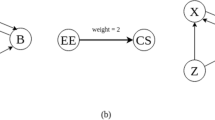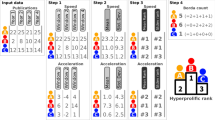Abstract
Representation and analysis of publication data in the form of a network has become a common method of illustrating and evaluating the scientific output of a group or of a scientific field. Co-authorship networks also reveal patterns and collaboration practices. In this paper we propose the use of a hypergraph model—a generalized network—to represent publication data by considering papers as hypergraph nodes. Hyperedges, connecting the nodes, represent the authors connecting all their papers. We show that this representation is more straightforward than other authorship network models. Using the hypergraph model we propose a collaboration measure of an author that reflects the influence of that author over the collaborations of its co-authors. We illustrate the introduced concepts by analyzing publishing data of computer scientists and mathematicians in Romania over a 10 year period.









Similar content being viewed by others
Notes
www.scopus.com accessed November 2016.
To verify the nature of the distribution the software associated with Clauset et al. (2009) was used (Available at http://tuvalu.santafe.edu/aaronc/powerlaws/ Accessed November 2016).
References
Abbasi, A., Chung, K. S. K., & Hossain, L. (2012). Egocentric analysis of co-authorship network structure, position and performance. Information Processing & Management, 48(4), 671–679.
Bakkalbasi, N., & Krichel, T. (2006). Patterns of research collaboration in a digital library for economics. Proceedings of the Association for Information Science and Technology, 43(1), 1–15.
Barabási, A. L., Jeong, H., Néda, Z., Ravasz, E., Schubert, A., & Vicsek, T. (2002). Evolution of the social network of scientific collaborations. Physica A: Statistical mechanics and its applications, 311(3), 590–614.
Börner, K., Dall’Asta, L., Ke, W., & Vespignani, A. (2005). Studying the emerging global brain: Analyzing and visualizing the impact of co-authorship teams. Complexity, 10(4), 57–67.
Brown, M. E., Ihli, M., Hendrick, O., Delgado-Arias, S., Escobar, V. M., & Griffith, P. (2016). Social network and content analysis of the north american carbon program as a scientific community of practice. Social Networks, 44, 226–237.
Cho, H., & Yu, Y. (2018). Link prediction for interdisciplinary collaboration via co-authorship network. Social Network Analysis and Mining, 8(1), 25.
Chuan, P. M., Ali, M., Khang, T. D., Dey, N., et al. (2018). Link prediction in co-authorship networks based on hybrid content similarity metric. Applied Intelligence, 48(8), 2470–2486.
Clauset, A., Shalizi, C. R., & Newman, M. E. (2009). Power-law distributions in empirical data. SIAM Review, 51(4), 661–703.
De Stefano, D., Giordano, G., & Vitale, M. P. (2011). Issues in the analysis of co-authorship networks. Quality & Quantity, 45(5), 1091–1107.
Eaton, J. P., Ward, J. C., Kumar, A., & Reingen, P. H. (1999). Structural analysis of co-author relationships and author productivity in selected outlets for consumer behavior research. Journal of Consumer Psychology, 8(1), 39–59.
Erman, N., & Todorovski, L. (2015). The effects of measurement error in case of scientific network analysis. Scientometrics, 104(2), 453–473.
Evans, T., Lambiotte, R., & Panzarasa, P. (2011). Community structure and patterns of scientific collaboration in business and management. Scientometrics, 89(1), 381–396.
Gaskó, N., Lung, R. I., & Suciu, M. A. (2016). A new network model for the study of scientific collaborations: Romanian computer science and mathematics co-authorship networks. Scientometrics, 108(2), 613–632.
Genest, C., & Thibault, C. (2001). Investigating the concentration within a research community using joint publications and co-authorship via intermediaries. Scientometrics, 51(2), 429–440.
Ghiasi, G., Harsh, M., & Schiffauerova, A. (2018). Inequality and collaboration patterns in canadian nanotechnology: Implications for pro-poor and gender-inclusive policy. Scientometrics, 115(2), 785–815.
Glänzel, W. (2001). National characteristics in international scientific co-authorship relations. Scientometrics, 51(1), 69–115.
Glänzel, W. (2002). Coauthorship patterns and trends in the sciences (1980-1998): A bibliometric study with implications for database indexing and search strategies. Library Trends.
Glänzel, W., & Schubert, A. (2004). Analysing scientific networks through co-authorship. In: Handbook of quantitative science and technology research, Springer, pp. 257–276.
Groh, G., & Fuchs, C. (2011). Multi-modal social networks for modeling scientific fields. Scientometrics, 89(2), 569.
Guns, R., & Rousseau, R. (2014). Recommending research collaborations using link prediction and random forest classifiers. Scientometrics, 101(2), 1461–1473.
Han, Y., Zhou, B., Pei, J., & Jia, Y. (2009). Understanding importance of collaborations in co-authorship networks: A supportiveness analysis approach. In: Proceedings of the 2009 SIAM international conference on data mining, SIAM, pp. 1112–1123.
Hâncean, M. G., Perc, M., & Vlăsceanu, L. (2014). Fragmented romanian sociology: Growth and structure of the collaboration network. PloS One, 9(11), e113,271.
Kim, J., & Diesner, J. (2014). A network-based approach to coauthorship credit allocation. Scientometrics, 101(1), 587–602.
Kim, J., & Diesner, J. (2015). Coauthorship networks: A directed network approach considering the order and number of coauthors. Journal of the Association for Information Science and Technology, 66(12), 2685–2696.
Kretschmer, H., & Kretschmer, T. (2006). Application of a new centrality measure for social network analysis to bibliometric and webometric data. In Digital information management, 2006 1st international conference on, IEEE, pp 199–204.
Kumar, S. (2015). Co-authorship networks: A review of the literature. Aslib Journal of Information Management, 67(1), 55–73.
Li, Y., & You, C. (2013). What is the difference of research collaboration network under different projections: Topological measurement and analysis. Physica A: Statistical Mechanics and its Applications, 392(15), 3248–3259.
Liu, Y. X., Lu, B., & Zhang, Q. (2013). Empirical analysis of the coauthorship network based on dblp. In: Machine learning and cybernetics (ICMLC), 2013 international conference on, IEEE, vol. 3, pp. 1070–1076.
Mena-Chalco, J. P., & Cesar Junior, R. M. (2011). Towards Automatic Discovery of co-authorship Networks in the Brazilian Academic Areas. In: 2011 IEEE Seventh international conference on e-science workshops, IEEE, pp. 53–60.
Metz, T., & Jäckle, S. (2017). Patterns of publishing in political science journals: An overview of our profession using bibliographic data and a co-authorship network. PS. Political Science & Politics, 50(1), 157–165.
Misue, K. (2008). Visual analysis tool for bipartite networks. In Knowledge-based intelligent information and engineering systems, Springer, pp. 871–878.
Neal, Z. (2014). The backbone of bipartite projections: Inferring relationships from co-authorship, co-sponsorship, co-attendance and other co-behaviors. Social Networks, 39, 84–97.
Olmeda-Gómez, C., Perianes-Rodriguez, A., Antonia Ovalle-Perandones, M., Guerrero-Bote, V. P., & de Moya, Anegón F. (2009). Visualization of scientific co-authorship in spanish universities: From regionalization to internationalization. In: Aslib Proceedings, Emerald Group Publishing Limited, vol. 61, pp. 83–100.
Perc, M. (2010). Growth and structure of slovenias scientific collaboration network. Journal of Informetrics, 4(4), 475–482.
Perc, M. (2014). The matthew effect in empirical data. Journal of The Royal Society Interface, 11(98), 20140,378.
Roy, S., & Ravindran, B. (2015). Measuring network centrality using hypergraphs. In Proceedings of the second ACM IKDD conference on data sciences, ACM, pp. 59–68.
Savić, M., Ivanović, M., Radovanović, M., Ognjanović, Z., Pejović, A., & Krüger, T. J. (2014). The structure and evolution of scientific collaboration in serbian mathematical journals. Scientometrics, 101(3), 1805–1830.
Savić, M., Ivanović, M., Radovanović, M., Ognjanović, Z., Pejović, A., & Krüger, T. J. (2015). Exploratory analysis of communities in co-authorship networks: A case study. In ICT Innovations 2014, Springer, pp. 55–64.
Acknowledgements
The authors would like to acknowledge the support received within the OPEN-RES Academic Writing Project 212/2012.
Author information
Authors and Affiliations
Corresponding author
Appendices
Appendix 1: Network measures
See Table 1 .
Appendix 2: Results of the power law test for the number of co-authors, papers published and collaboration measure
See Figs. 14, 15, 16, 17, 18 , 19.
Correlation matrices for the number of papers, number of co-authors, and correlation measure, respectively, for the field of Computer Science (top) and Mathematics (bottom). The main diagonal presents the histogram of the corresponding variable. A regression line and correlation value is presented for each pair of variables
Correlation matrices for closeness centrality, betweenness centrality and collaboration measure \(\mu _C\) for each author, respectively, for the field of Computer Science (top) and Mathematics (bottom). The main diagonal presents the histogram of the corresponding variable. A regression line and correlation value is presented for each pair of variables
Rights and permissions
About this article
Cite this article
Lung, R.I., Gaskó, N. & Suciu, M.A. A hypergraph model for representing scientific output. Scientometrics 117, 1361–1379 (2018). https://doi.org/10.1007/s11192-018-2908-2
Received:
Published:
Issue Date:
DOI: https://doi.org/10.1007/s11192-018-2908-2














